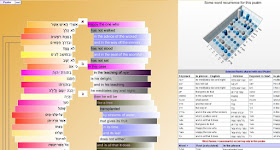Welcome to Février Gras.
This is The Biblical Studies Carnival 3x7x23
completing 168 monthly editions since the inaugural BS carnival 180 months ago,
music, poetry, art in celebration of those studying the ancient texts.
 |
| Official colours of Mardi Gras |
The head of the first parade is Deane Galbraith presenting Marc Zvi Brettler's lecture on Jewish Biblical Scholarship.
Torah
All sorts of free goodies distributed from this krewe.
Laurent Sangpo gives us a 5 minute reception history on Le Déluge de Michel-Ange."...il suit ainsi l’exégèse ancienne, qui voyait dans la catastrophe la représentation symbolique de notre monde."
Mark Leuchter and Zev Farber describe the relationship of the siblings, Moses, Miriam, and Aaron, "partners of similar standing in redeeming the people".
Carol Meyers asks Who wrote the song?
Athalya Brenner-Idan has updated an essay from 2016, Are female readers included in the Decalogue?
Sandra Jacobs writes on Exodus 21:22-25: Accidental Injuries in a Public Brawl, 3 interpretations of the degree and type of compensation required.
A d'varling from the Velveteen Rabbi, "if you keep making that face, you'll get stuck that way."
Prophets
Pete Enns brings up the violence against the Canaanites.
Aaron Koller writes on Composing the Song of Deborah, "here we have two empirical models with clear parallels to the biblical Song of Deborah, and both are well attested and fairly well understood."
| Judges 5:2 (The whole song is here.) |
Brant Pitre introduces the lessons for the Presentation in the Temple with particular emphasis on Malachi and the Twelve.
Writings
... A symphony of voices
Kate Thomas presents a medieval manuscript in praise of the Psalms. De laude psalmorum. "This short Latin treatise explains why saying the Psalms was considered spiritually beneficial, and which Psalms were good for which purposes. It opens a window onto how medieval people understood one of the most important liturgical and devotional books of the Middle Ages, the Psalter."
| A hole in the parchment, through which the word 'gratiam' ('grace') is visible |
Brent Niedergall posts on a textual issue in Ruth. "What if an English Bible translation translated a Hebrew word meaning 'he' as 'she'?"
Marg Mowczko begins a series on Esther, and continues with a second post, For such a time as this. The girls "weren’t volunteering for a wonderful opportunity. They weren’t competing for a marvellous prize. Most may well have been taken against their will and against the hopes of their families who might never see their girls again."
 |
| Esther: Girls of marriageable age in the ancient world were much younger than brides today in the western world. |
Marg Mowczko begins a series on Esther, and continues with a second post, For such a time as this. The girls "weren’t volunteering for a wonderful opportunity. They weren’t competing for a marvellous prize. Most may well have been taken against their will and against the hopes of their families who might never see their girls again."
 |
| Daniel became a writer |
| Daniel 5:25 - setting the words, the accents in their simplest form |
 |
| Psalm 150 Karaite |
The tail of the Krewe of TNK
Your host posted a tabular comparison of two strategies for explaining the accents of the TNK and a brief on reading with the music stimulated by the medieval book on the accents translated by Geoffrey Khan, The Tiberian Pronunciation Tradition of Biblical Hebrew.
Benjamin Kantor officially launches the Tiberian Hebrew page here. Jonathan Orr-Stav responds to a question on Tiberian pronunciation.
Jim Davila highlights an article on dating the Hebrew Bible through linguistics.
And, via William Ross, the LXX has its international day.
A quote from the obit for S. R. Driver (for links see the final parade below):
Benjamin Kantor officially launches the Tiberian Hebrew page here. Jonathan Orr-Stav responds to a question on Tiberian pronunciation.
Jim Davila highlights an article on dating the Hebrew Bible through linguistics.
And, via William Ross, the LXX has its international day.
A quote from the obit for S. R. Driver (for links see the final parade below):
The Old Testament must remain an ever-fresh fountainhead of living truth, able to invigorate and restore, to purify and refine, to ennoble and enrich, the moral and spiritual being of man.The Krewe of the NT
Travis Proctor heads the second parade with an exploration of the demonic body, "residual souls of antediluvian giants".
 |
| If it quacks... |
Bart Ehrman reviews a Newly Discovered gospel. "rarely does anyone actually discuss the actual *evidence*". His post reaches back into the archives.
Ekaterini G. Tsalampouni points us to an article on the ending of Mark.
James McGrath posts his impressions of the Enoch Seminar's dedicated session at AAR/SBL on Adele Reinhartz's book Cast Out of the Covenant: Jews and Anti-Judaism in the Gospel of John.
Johnson Thomaskutty writes on the Characterization of Thomas in the fourth Gospel.
Andrew Perriman writes in response to Michael Bird, on the church and the mission of Jesus. "Did they succeed? Fail? Or did someone move the goalposts?"
Ken Schenck points out his work on Mark and Acts as part of his project Through the Bible in Ten Years.
Richard Beck continues his series on the gospel according to the Lord of the Rings.
 |
| A Matthean Thunderbolt? |
Michael Pahl encourages following the teaching on economics from Jesus.
Jim Gordon would have us consider ornitheology. His series for Lent holds promise. Here is the leap-day special, the pearl.
Chuck Jones points out Vizualizing Acts, graphic online support for reading Acts.
Letters
James Tabor writes about What Paul claimed to have seen.
Andrew Perriman posts on theological prisons vs historical readings of Romans.
Michael Kok continues his series on Corinthians, beginning with notes on Peter, and Apollos.
James McGrath points to a note on Paul's letter carriers.
Henry Neufeld writes about How to Read Hebrews 4.
Revelation
James McGrath points to a note on Paul's letter carriers.
Henry Neufeld writes about How to Read Hebrews 4.
Revelation
Very short parade.
The tail of the Krewe of the NT
Mike Aubrey wants more language resources for translation.
Marg Mowcsko talks about "preaching" words in the NT.
The tail of the first two Krewes
Pete Enns and Jared Byas have some advice to their fellow citizens on how to read the Bible in 2020.
Jim West reviews the Jesus Bible, i.e. how not to read the Bible.
The tail of the Krewe of the NT
Mike Aubrey wants more language resources for translation.
Marg Mowcsko talks about "preaching" words in the NT.
The tail of the first two Krewes
Pete Enns and Jared Byas have some advice to their fellow citizens on how to read the Bible in 2020.
Jim West reviews the Jesus Bible, i.e. how not to read the Bible.
Other Krewes
James McGrath posts on the SpaceX Rocket bouncing off the firmament. You can watch the whole thing with exegetical commentary from a booster seat. Just click on the image.
Archaeology
Jim Davila asks if Solomon's temple had competition? He also has some thoughts on information in a vitrified brain. And a list of posts on the BAR spring 2020 release including one from the original xkv8r.
Todd Bolen reports on extensive ruins of a Canaanite temple dating to the 12th century BCE at Lachish.
Yana Tchekhanovets and Leonid Belyaev write about Russian archaeology in The Ancient Near East Today.
Textual criticism
Sarah MacDonald presents "Silent in the Churches", an exploration of Music in the liturgy by female composers.
NT Wright explains penal substitution, 'according to the Scriptures'. And here's a C.R.A.S.S.H course on explaining.
Who knew that James McGrath was an award winning Mandaic poet?
Matt Page is still blogging about Bible films. Here is an entry on the Netflix Messiah.
Both Bosco Peters and Airtonjo have things to point out about Querida Amazônia.
John Bergsma on the Sacred Page lays out the lessons for the sixth Sunday in Ordinary Time.
Alex Finkelson at Scribes of the Kingdom wonders about the promises to David.
A slightly early entry for the Revelation parade from Doug Chaplin. (Ah well, February is a short month and January is long, so let's give them 30 days each this year... and he is still writing occasionally.)
Bart Ehrman has some interesting questions from Buddhists.
John Jillions writes on the religious attitudes of some famous Roman skeptics.
Journals and Reviews and other things
James McGrath points out a new open-access Journal of Religious Competition in Antiquity.
James also notes this announcement on Women interpreting the Scripture through music and the arts.
Kelsi Morrison-Atkins reviews Moshe Blidstein. Purity, Community, and Ritual in Early Christian Literature. 'Blidstein guides the reader through the “web of allusions” that characterized early Christian purity discourses in the first through third centuries.'
Noah Benjamin Bickart reviews Paula Fredricksen's When Christians were Jews. "If anything is missing in her excellent book, it is a more robust engagement with rabbinic texts."
Steve Walton notes a set of essays from a conference, Healing and Exorcism in Second Temple Judaism and Early Christianity.
Ben Witherington's book on Priscilla is reviewed by Kelley Matthews.
Bart Ehrman has a very nice promotion of his book, Heaven and Hell.
Brent Niedergall is working with Bel and the Dragon on a Reddit reading group here.
Jim Davila points out Sonja Noll's book on the Semantics of Silence in Biblical Hebrew. And a collection of essays on Parables. "Essays cover parables in the synoptic Gospels, Rabbinic midrash, and parabolic tales and fables in the Babylonian Talmud. Three essays address parables in Islam and Buddhism." And Henk de Waard's Jeremiah 52, "Jeremiah 52 is not a mere appendix to the book, but a golah-oriented epilogue, indicating the contrasting destinies of pre-exilic Judah and the exilic community in Babylon."
Kerry Sonia reviews Shawn Flynn's Children in Ancient Israel
Kathleen Gallagher Elkins reviews The Bible and Feminism: Remapping the Field.
BLT reports on Suzanne McCarthy's book as told to James McGrath by her sister Ruth Hayhoe.
Phil Long reviews All Things New, Revelation as canonical capstone, by Brian Tabb.
Remembering
James McGrath posts on the SpaceX Rocket bouncing off the firmament. You can watch the whole thing with exegetical commentary from a booster seat. Just click on the image.
Archaeology
Jim Davila asks if Solomon's temple had competition? He also has some thoughts on information in a vitrified brain. And a list of posts on the BAR spring 2020 release including one from the original xkv8r.
Todd Bolen reports on extensive ruins of a Canaanite temple dating to the 12th century BCE at Lachish.
Yana Tchekhanovets and Leonid Belyaev write about Russian archaeology in The Ancient Near East Today.
Textual criticism
Drew Longacre reports on Feature-extraction methods for historical manuscript dating based on handwriting analysis.
James McGrath gets around to writing up the 2019 Digital Humanities AAR/SBL sessions in San Diego.
Jim West quotes Jerome in defense of errors in his rendering of the Bible.
Sarah Allen interviews Zachary Cole on his chapter in Myths and Mistakes.
James McGrath gets around to writing up the 2019 Digital Humanities AAR/SBL sessions in San Diego.
Jim West quotes Jerome in defense of errors in his rendering of the Bible.
Sarah Allen interviews Zachary Cole on his chapter in Myths and Mistakes.
Theology and Liturgy
 |
| Great St Mary's, the Selwyn Consort via the Minerva Festival |
NT Wright explains penal substitution, 'according to the Scriptures'. And here's a C.R.A.S.S.H course on explaining.
Who knew that James McGrath was an award winning Mandaic poet?
Matt Page is still blogging about Bible films. Here is an entry on the Netflix Messiah.
Both Bosco Peters and Airtonjo have things to point out about Querida Amazônia.
John Bergsma on the Sacred Page lays out the lessons for the sixth Sunday in Ordinary Time.
Alex Finkelson at Scribes of the Kingdom wonders about the promises to David.
A slightly early entry for the Revelation parade from Doug Chaplin. (Ah well, February is a short month and January is long, so let's give them 30 days each this year... and he is still writing occasionally.)
Bart Ehrman has some interesting questions from Buddhists.
John Jillions writes on the religious attitudes of some famous Roman skeptics.
Journals and Reviews and other things
James McGrath points out a new open-access Journal of Religious Competition in Antiquity.
James also notes this announcement on Women interpreting the Scripture through music and the arts.
Kelsi Morrison-Atkins reviews Moshe Blidstein. Purity, Community, and Ritual in Early Christian Literature. 'Blidstein guides the reader through the “web of allusions” that characterized early Christian purity discourses in the first through third centuries.'
Noah Benjamin Bickart reviews Paula Fredricksen's When Christians were Jews. "If anything is missing in her excellent book, it is a more robust engagement with rabbinic texts."
Steve Walton notes a set of essays from a conference, Healing and Exorcism in Second Temple Judaism and Early Christianity.
Ben Witherington's book on Priscilla is reviewed by Kelley Matthews.
Bart Ehrman has a very nice promotion of his book, Heaven and Hell.
 |
| Fetch |
Jim Davila points out Sonja Noll's book on the Semantics of Silence in Biblical Hebrew. And a collection of essays on Parables. "Essays cover parables in the synoptic Gospels, Rabbinic midrash, and parabolic tales and fables in the Babylonian Talmud. Three essays address parables in Islam and Buddhism." And Henk de Waard's Jeremiah 52, "Jeremiah 52 is not a mere appendix to the book, but a golah-oriented epilogue, indicating the contrasting destinies of pre-exilic Judah and the exilic community in Babylon."
Kerry Sonia reviews Shawn Flynn's Children in Ancient Israel
Kathleen Gallagher Elkins reviews The Bible and Feminism: Remapping the Field.
BLT reports on Suzanne McCarthy's book as told to James McGrath by her sister Ruth Hayhoe.
Phil Long reviews All Things New, Revelation as canonical capstone, by Brian Tabb.
Suzanne McCarthy 76 months ago reminded us of a riddle related to time.
Here is a Sunday Superlatives post from the same year, 2013, from Rachel Held Evans.
Jim Gordon reminds us of the 75th anniversary of the death of Bonhoeffer.
The tail of the whole carnival is a reflection by Marc Zvi Brettler on the 106th yahrzeit of S. R. Driver of whom, it is said: He taught the faithful criticism and the critics faith. Read Marc's article to find out who said this and more importantly, why.
And as a coda, this music, which as Matthew Larkin says, if you allow yourself the necessary time, "will leave you speechless".
Here is a Sunday Superlatives post from the same year, 2013, from Rachel Held Evans.
Jim Gordon reminds us of the 75th anniversary of the death of Bonhoeffer.
The tail of the whole carnival is a reflection by Marc Zvi Brettler on the 106th yahrzeit of S. R. Driver of whom, it is said: He taught the faithful criticism and the critics faith. Read Marc's article to find out who said this and more importantly, why.
And as a coda, this music, which as Matthew Larkin says, if you allow yourself the necessary time, "will leave you speechless".
Next Carnivals
Brent Niedergall hosts in March 2020 (Due April 1). Phillip Long is looking for volunteers for the rest of 2020. Contact him at plong42@gmail.com or twitter dm @plong42 to volunteer to host!
----------
The number of this February carnival is the product of the first two perfect numbers, 6 and 28, and is also the count of primes less than 1000. There are 50 words in TNK with gematria = 168. See also.
(2) right hand side linked poetry snippets by James McGrath.






